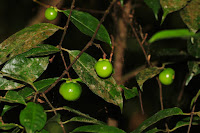 |
| Garcinia siripatanadilokii Ngerns., Meeprom, Boonth., Chamch. & Sinbumr., in Ngernsaengsaruay, Meeprom, Boonthasak, Chamchumroon, et al., 2022. |
Summary
Garcinia siripatanadilokii Ngerns., Meeprom, Boonth., Chamch. & Sinbumr. (Clusiaceae), a new species discovered from tropical lowland evergreen rain forest, Peninsular Thailand, is described. A detailed morphological description and illustrations of the species are provided, along with information on recognition, distribution, specimens examined, habitat, conservation assessment, phenology, etymology, vernacular name and uses.
Key Words: Garcinia sect. Brindonia, dioecious plant, edible fruits, Garcinia lanceifolia, Khao Chong, plant taxonomy, species nova, yellow latex
Garcinia siripatanadilokii Ngerns., Meeprom, Boonth., Chamch. & Sinbumr., sp. nov.
RECOGNITION. Garcinia siripatanadilokii is similar to G. lanceifolia in its habit (shrub or small tree), 4-merous flowers, sepals and petals decussate and concave, stigma radiate, shallowly lobed, papillate, fresh leaves crispy when crushed, fruits and leaves have a sour taste. Differences between these two related species are shown in Table 1.
DISTRIBUTION. Known only from Peninsular Thailand: Khao Chong, Trang Province, Khlong Ton, Satun Province and Hala-Bala Wildlife Sanctuary, Narathiwat Province, but to be expected in Peninsular Malaysia.
ETYMOLOGY. The specific epithet and Thai name are in honour of Dr Somkid Siripatanadilok, the former Associate Professor of the Department of Forest Biology, Faculty of Forestry. He taught the forest biology component of courses in field forest biology (in Peninsular Thailand, Khao Chong Botanical Garden is one of several study areas of the course), anatomy of trees, plant tissue culture and research techniques in forest biology (plant microtechniques) when the first author was an undergraduate student and a graduate student at Kasetsart University. He encouraged and supported the first author to work in the laboratory for plant tissue culture as an undergraduate student (1994 – 1997). He was the former co-advisor of the first author in his master's degree (1997 – 2000). He was a superb and a brilliant teacher, actively involved in many aspects of forest science in Thailand.
VERNACULAR NAME. Som Kaeo Somkid (ส้มแก้วสมคิด) (suggested here); Som Kaeo (ส้มแก้ว) (Satun) (from A. F. G. Kerr 14580).
USES. The ripe fruits are edible. The pericarp, sarcotesta, young shoots, leaves and flowers have a sour taste. It is suitable for cultivation as an ornamental.
Chatchai Ngernsaengsaruay, Nattanon Meeprom, Weereesa Boonthasak, Voradol Chamchumroon, Aroon Sinbumroong, Paweena Wessapak and Sutee Duangjai. 2022. Garcinia siripatanadilokii (Clusiaceae), A New Species from Peninsular Thailand. Kew Bulletin. DOI: 10.1007/s12225-022-10059-8







